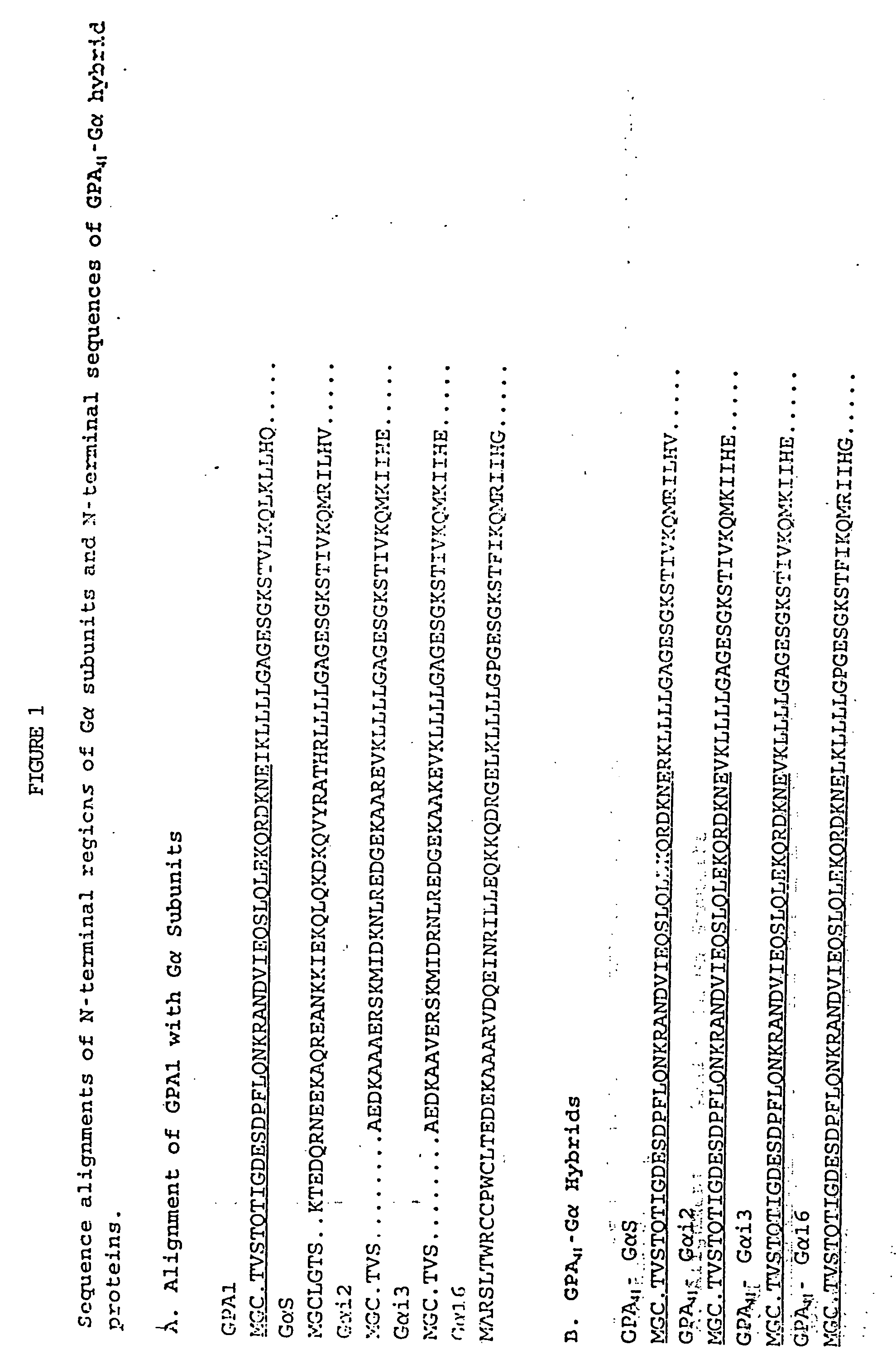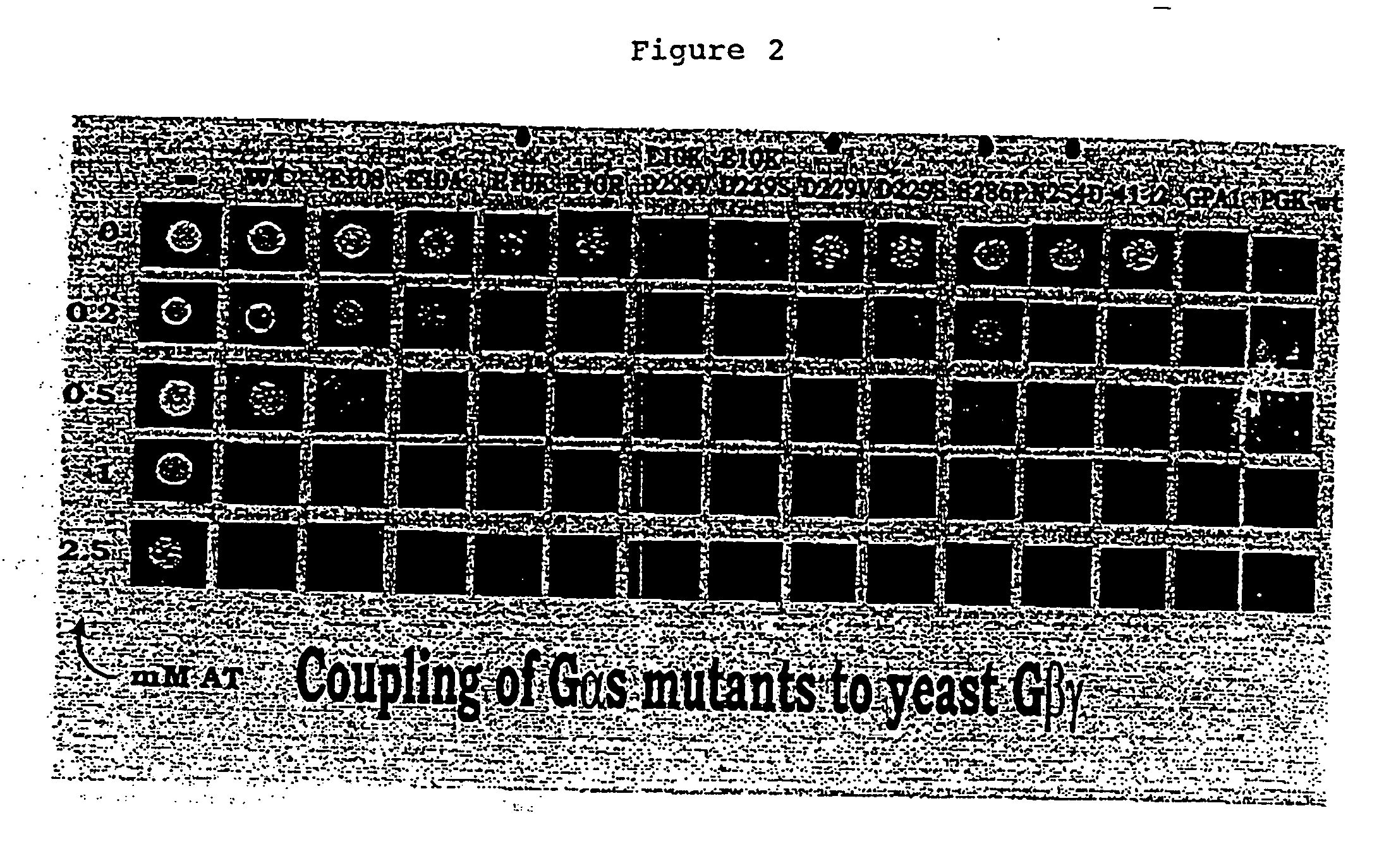Yeast cells expressing modified G proteins and methods of use therefor
a technology of g protein and g protein, which is applied in the field of g protein expressing yeast cells and methods of use therefor, can solve the problems of particular challenges for modulators of these receptors, coupling and functional integration, and achieve enhanced heterologous expression of receptors and enhanced coupling of heterologous expressed gpcrs to g protein subunits.
- Summary
- Abstract
- Description
- Claims
- Application Information
AI Technical Summary
Benefits of technology
Problems solved by technology
Method used
Image
Examples
example 1
Construction of Chimeric Yeast / Mammalian Gα Subunits
[0283] This Example pertains to the construction of chimeric G protein subunits which are made using a first polypeptide derived from a yeast G protein subunit and a second polypeptide derived from a mammalian G protein subunit. The Gα subunit of heterotrimeric G proteins interacts with both the βγ complex and the receptor. The construction of chimeric α subunits can, therefore, enhance receptor coupling. In this example, various G protein subunit chimeras were constructed using a polypeptide derived from yeast GPA1 and several different mammalian Gα subunits. The nucleotide sequence of GPA1 is known in the art. For example, the gene encoding a G protein homolog of S. cerevisiae was cloned independently by Dietzel and Kurjan (supra) (who referred to the gene as SCG1) and by Nakafuku, et al. (1987 Proc Natl Acad Sci 84:2140-2144) (who called the gene GPA1). The nucleotide sequence of the human G alpha subunits Gαs, Gαi2, Gαi3 also ...
example 2
Identification of Critical Regions of Gα and Improvement of the Interaction of Mammalian Gαs with Yeast βγ by Mutation
[0294] In this Example, critical regions of various mammalian Gα subunits were identified by making the following series of mutations:
D229S in rat Gαs, S270P in human Gα16, S280P in Gpal-Gαi2-GαoB and S288P in GPA1-Gα12
[0295] The specificity of coupling of a receptor to a heterotrimeric G-protein is largely determined by the α subunit of the G-protein. This fact has been exploited by expressing human 7 transmembrane receptors in yeast and functionally coupling them into the yeast pheromone response pathway, as a path to drug discovery. In order to accomplish this goal mammalian Gα subunits were expressed in yeast cells whose own pheromone-responsive Gα subunit (GPA1), has been disrupted. As the predominant role of GPA1 is to bind to and sequester the effector-signaling βγ component of the heterotrimer, the effector activity of the mammalian Gα is irrelevant; the ...
example 3
Construction of STE18 / Mammalian Gγ Chimeric Proteins
[0319] Chimeric proteins comprising STE18, the wild type Gγ subunit of yeast, were also made. The wild type STE18 nucleotide sequence is available in the art. The carobxy terminal 34 amino acids of STE18 are as follows:
GYPVAGSNHFIEGLKNAQKNSQMSNSNSVCCTLM(SEQ ID NO: 29)
[0320] The wild type human Gγ nucleotide sequences are available in the art. The carboxy terminal 24 amino acids of human Gγ are as follows:
DPLLTPVPASENPFREKKFFCAIL(SEQ ID NO: 30)
The underlined residues shown are conserved among all of the mammalian Gγ subunits
[0321] The STE18-mammalian Gγ chimeras were constructed using standard molecular biology techniques. The following is a list of the Gγ chimeras which were generated, all are modified forms of yeast STE18 which comprise a portion of a Gγ subunit. The sequences shown below represent a carboxy terminal alignment of the sequences. The two dots before the first amino acid shown in each of the sequences in the f...
PUM
| Property | Measurement | Unit |
|---|---|---|
| pH | aaaaa | aaaaa |
| fluorescent | aaaaa | aaaaa |
| green fluorescent | aaaaa | aaaaa |
Abstract
Description
Claims
Application Information
 Login to View More
Login to View More - R&D
- Intellectual Property
- Life Sciences
- Materials
- Tech Scout
- Unparalleled Data Quality
- Higher Quality Content
- 60% Fewer Hallucinations
Browse by: Latest US Patents, China's latest patents, Technical Efficacy Thesaurus, Application Domain, Technology Topic, Popular Technical Reports.
© 2025 PatSnap. All rights reserved.Legal|Privacy policy|Modern Slavery Act Transparency Statement|Sitemap|About US| Contact US: help@patsnap.com



